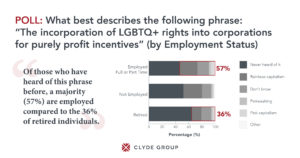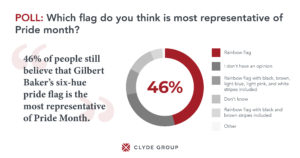Insights
New Survey Shows Divided Perception on Pride Flag & Rainbow Capitalism Among Company Stakeholders.

As part of Clyde Group’s observance and celebration of Pride Month this year, the agency commissioned a nationwide survey on public perception of LGBTQ+ representation and celebration. The survey specifically focused on the knowledge and growing prevalence of rainbow capitalism— companies using Pride purely as a means for profit— as well as the preferred versions of the rainbow flag. The findings, analyzed below, reveal an evolving and divided perspective on how corporations are and should be engaging directly with the queer community.
 Half of Americans have heard of the phrase, “The incorporation of the LGBTQ+ rights into corporations for purely profit incentives.”
Half of Americans have heard of the phrase, “The incorporation of the LGBTQ+ rights into corporations for purely profit incentives.”
 Of those who have heard of this phrase before, a majority (57%) are employed compared to the 36% of retired individuals.
Of those who have heard of this phrase before, a majority (57%) are employed compared to the 36% of retired individuals.
 Men between 18-34 were the group that has heard of this trend the most.
As more and more corporations and big brands started to embrace Pride sentiment and products, it was initially seen as support for progressiveness and a gay-friendly environment. However, many Americans have started to pick up on what is now known as “rainbow capitalism” or “pink capitalism”— taking a more critical view of the way big brands, mainstream media and pop culture are now monetizing on the LGBTQ+ culture.
Clyde Group data shows that 50% of Americans polled are aware of companies incorporating LGBTQ+ rights for purely profit incentives. Among the most aware of rainbow capitalism was a vast majority of men between 18-35 years— which likely serves as a bellwether for an even greater shift in the scrutiny of the way companies communicate their support of Pride as younger generations grow older.
Why is this important?
As the prominence of rainbow capitalism grows, some say— despite what the real end goal is for the companies— that this is a positive thing for the LGBTQ+ community. Pride, as the country has seen it evolve over the past decade, could likely not exist without corporate sponsors writing checks. Pink capitalism can also take credit for being the catalyst that helped normalize the LGBTQ+ community and raise awareness and acceptance.
However, it is important that consumers are aware of pink capitalism and continue to scrutinize how companies incorporate LBGTQ+ rights into their marketing purely for profit. Without a true understanding of the political goals, idealistic concerns, and general welfare of this community, their message can be alienating. This is because they often pander to the stereotypical white, affluent, cisgender gay man, whilst sideling people of color, women, and trans people. Pink capitalism also can be seen as incredibly reductionist of the LGBTQ+ community generalizing people to stereotypes— highly simplifying and minimizing the experience.
Men between 18-34 were the group that has heard of this trend the most.
As more and more corporations and big brands started to embrace Pride sentiment and products, it was initially seen as support for progressiveness and a gay-friendly environment. However, many Americans have started to pick up on what is now known as “rainbow capitalism” or “pink capitalism”— taking a more critical view of the way big brands, mainstream media and pop culture are now monetizing on the LGBTQ+ culture.
Clyde Group data shows that 50% of Americans polled are aware of companies incorporating LGBTQ+ rights for purely profit incentives. Among the most aware of rainbow capitalism was a vast majority of men between 18-35 years— which likely serves as a bellwether for an even greater shift in the scrutiny of the way companies communicate their support of Pride as younger generations grow older.
Why is this important?
As the prominence of rainbow capitalism grows, some say— despite what the real end goal is for the companies— that this is a positive thing for the LGBTQ+ community. Pride, as the country has seen it evolve over the past decade, could likely not exist without corporate sponsors writing checks. Pink capitalism can also take credit for being the catalyst that helped normalize the LGBTQ+ community and raise awareness and acceptance.
However, it is important that consumers are aware of pink capitalism and continue to scrutinize how companies incorporate LBGTQ+ rights into their marketing purely for profit. Without a true understanding of the political goals, idealistic concerns, and general welfare of this community, their message can be alienating. This is because they often pander to the stereotypical white, affluent, cisgender gay man, whilst sideling people of color, women, and trans people. Pink capitalism also can be seen as incredibly reductionist of the LGBTQ+ community generalizing people to stereotypes— highly simplifying and minimizing the experience.
 46% of people still believe that Gilbert Baker’s six-hue pride flag is the most representative of Pride Month.
While that may not seem surprising at first glance, it indicates that the recent surge in popularity of Daniel Quasar’s Progress Flag may not be as widespread as it would seem. Only 11% of respondents chose the Progress Flag as most representative of Pride Month. However, countless major companies in the U.S. and around the world have incorporated the additional light blue, white, pink, black, and brown colors into their corporate logos. This move aligns with a greater emphasis on stakeholder capitalism, the concept that companies must make business decisions based on the demands of all stakeholders, not just shareholders. But if the majority of those stakeholders still think Baker’s flag is most representative, why are companies embracing Quasar’s Progress flag? What is the disconnect?
One reason may be that the wholesale acceptance of the Progress Flag by the corporate community is a result of social justice activists’ tireless advocacy for more inclusive representation in mainstream society. If companies are to celebrate Pride authentically, LGBTQ+ people, communities of color, and other marginalized groups want to see themselves represented in that celebration. Pushback on companies that are engaging in rainbow capitalism have made businesses think twice about tokenistic marketing. The embrace of a more progressive representation of Pride, even if a majority of stakeholders might not be aware of the meaning behind this shift, indicates companies’ desire to be ahead of the societal curve. And while some companies may be using the Progress flag just like they used Baker’s flag—for their own selfish gains—it could be argued that this move actually helps encourage inclusivity and authentic representation during Pride Month. After all, corporations that have a massive reach could help move the needle toward more inclusive representation and celebration of queer people on a national and global scale.
Looking Ahead
This survey is only the tip of the Pride marketing iceberg. Perceptions have and will continue to shift around how people think companies should represent themselves and their commitment to LGBTQ+ people during and beyond June.
46% of people still believe that Gilbert Baker’s six-hue pride flag is the most representative of Pride Month.
While that may not seem surprising at first glance, it indicates that the recent surge in popularity of Daniel Quasar’s Progress Flag may not be as widespread as it would seem. Only 11% of respondents chose the Progress Flag as most representative of Pride Month. However, countless major companies in the U.S. and around the world have incorporated the additional light blue, white, pink, black, and brown colors into their corporate logos. This move aligns with a greater emphasis on stakeholder capitalism, the concept that companies must make business decisions based on the demands of all stakeholders, not just shareholders. But if the majority of those stakeholders still think Baker’s flag is most representative, why are companies embracing Quasar’s Progress flag? What is the disconnect?
One reason may be that the wholesale acceptance of the Progress Flag by the corporate community is a result of social justice activists’ tireless advocacy for more inclusive representation in mainstream society. If companies are to celebrate Pride authentically, LGBTQ+ people, communities of color, and other marginalized groups want to see themselves represented in that celebration. Pushback on companies that are engaging in rainbow capitalism have made businesses think twice about tokenistic marketing. The embrace of a more progressive representation of Pride, even if a majority of stakeholders might not be aware of the meaning behind this shift, indicates companies’ desire to be ahead of the societal curve. And while some companies may be using the Progress flag just like they used Baker’s flag—for their own selfish gains—it could be argued that this move actually helps encourage inclusivity and authentic representation during Pride Month. After all, corporations that have a massive reach could help move the needle toward more inclusive representation and celebration of queer people on a national and global scale.
Looking Ahead
This survey is only the tip of the Pride marketing iceberg. Perceptions have and will continue to shift around how people think companies should represent themselves and their commitment to LGBTQ+ people during and beyond June.
 Half of Americans have heard of the phrase, “The incorporation of the LGBTQ+ rights into corporations for purely profit incentives.”
Half of Americans have heard of the phrase, “The incorporation of the LGBTQ+ rights into corporations for purely profit incentives.”
 Of those who have heard of this phrase before, a majority (57%) are employed compared to the 36% of retired individuals.
Of those who have heard of this phrase before, a majority (57%) are employed compared to the 36% of retired individuals.
 Men between 18-34 were the group that has heard of this trend the most.
As more and more corporations and big brands started to embrace Pride sentiment and products, it was initially seen as support for progressiveness and a gay-friendly environment. However, many Americans have started to pick up on what is now known as “rainbow capitalism” or “pink capitalism”— taking a more critical view of the way big brands, mainstream media and pop culture are now monetizing on the LGBTQ+ culture.
Clyde Group data shows that 50% of Americans polled are aware of companies incorporating LGBTQ+ rights for purely profit incentives. Among the most aware of rainbow capitalism was a vast majority of men between 18-35 years— which likely serves as a bellwether for an even greater shift in the scrutiny of the way companies communicate their support of Pride as younger generations grow older.
Why is this important?
As the prominence of rainbow capitalism grows, some say— despite what the real end goal is for the companies— that this is a positive thing for the LGBTQ+ community. Pride, as the country has seen it evolve over the past decade, could likely not exist without corporate sponsors writing checks. Pink capitalism can also take credit for being the catalyst that helped normalize the LGBTQ+ community and raise awareness and acceptance.
However, it is important that consumers are aware of pink capitalism and continue to scrutinize how companies incorporate LBGTQ+ rights into their marketing purely for profit. Without a true understanding of the political goals, idealistic concerns, and general welfare of this community, their message can be alienating. This is because they often pander to the stereotypical white, affluent, cisgender gay man, whilst sideling people of color, women, and trans people. Pink capitalism also can be seen as incredibly reductionist of the LGBTQ+ community generalizing people to stereotypes— highly simplifying and minimizing the experience.
Men between 18-34 were the group that has heard of this trend the most.
As more and more corporations and big brands started to embrace Pride sentiment and products, it was initially seen as support for progressiveness and a gay-friendly environment. However, many Americans have started to pick up on what is now known as “rainbow capitalism” or “pink capitalism”— taking a more critical view of the way big brands, mainstream media and pop culture are now monetizing on the LGBTQ+ culture.
Clyde Group data shows that 50% of Americans polled are aware of companies incorporating LGBTQ+ rights for purely profit incentives. Among the most aware of rainbow capitalism was a vast majority of men between 18-35 years— which likely serves as a bellwether for an even greater shift in the scrutiny of the way companies communicate their support of Pride as younger generations grow older.
Why is this important?
As the prominence of rainbow capitalism grows, some say— despite what the real end goal is for the companies— that this is a positive thing for the LGBTQ+ community. Pride, as the country has seen it evolve over the past decade, could likely not exist without corporate sponsors writing checks. Pink capitalism can also take credit for being the catalyst that helped normalize the LGBTQ+ community and raise awareness and acceptance.
However, it is important that consumers are aware of pink capitalism and continue to scrutinize how companies incorporate LBGTQ+ rights into their marketing purely for profit. Without a true understanding of the political goals, idealistic concerns, and general welfare of this community, their message can be alienating. This is because they often pander to the stereotypical white, affluent, cisgender gay man, whilst sideling people of color, women, and trans people. Pink capitalism also can be seen as incredibly reductionist of the LGBTQ+ community generalizing people to stereotypes— highly simplifying and minimizing the experience.
 46% of people still believe that Gilbert Baker’s six-hue pride flag is the most representative of Pride Month.
While that may not seem surprising at first glance, it indicates that the recent surge in popularity of Daniel Quasar’s Progress Flag may not be as widespread as it would seem. Only 11% of respondents chose the Progress Flag as most representative of Pride Month. However, countless major companies in the U.S. and around the world have incorporated the additional light blue, white, pink, black, and brown colors into their corporate logos. This move aligns with a greater emphasis on stakeholder capitalism, the concept that companies must make business decisions based on the demands of all stakeholders, not just shareholders. But if the majority of those stakeholders still think Baker’s flag is most representative, why are companies embracing Quasar’s Progress flag? What is the disconnect?
One reason may be that the wholesale acceptance of the Progress Flag by the corporate community is a result of social justice activists’ tireless advocacy for more inclusive representation in mainstream society. If companies are to celebrate Pride authentically, LGBTQ+ people, communities of color, and other marginalized groups want to see themselves represented in that celebration. Pushback on companies that are engaging in rainbow capitalism have made businesses think twice about tokenistic marketing. The embrace of a more progressive representation of Pride, even if a majority of stakeholders might not be aware of the meaning behind this shift, indicates companies’ desire to be ahead of the societal curve. And while some companies may be using the Progress flag just like they used Baker’s flag—for their own selfish gains—it could be argued that this move actually helps encourage inclusivity and authentic representation during Pride Month. After all, corporations that have a massive reach could help move the needle toward more inclusive representation and celebration of queer people on a national and global scale.
Looking Ahead
This survey is only the tip of the Pride marketing iceberg. Perceptions have and will continue to shift around how people think companies should represent themselves and their commitment to LGBTQ+ people during and beyond June.
46% of people still believe that Gilbert Baker’s six-hue pride flag is the most representative of Pride Month.
While that may not seem surprising at first glance, it indicates that the recent surge in popularity of Daniel Quasar’s Progress Flag may not be as widespread as it would seem. Only 11% of respondents chose the Progress Flag as most representative of Pride Month. However, countless major companies in the U.S. and around the world have incorporated the additional light blue, white, pink, black, and brown colors into their corporate logos. This move aligns with a greater emphasis on stakeholder capitalism, the concept that companies must make business decisions based on the demands of all stakeholders, not just shareholders. But if the majority of those stakeholders still think Baker’s flag is most representative, why are companies embracing Quasar’s Progress flag? What is the disconnect?
One reason may be that the wholesale acceptance of the Progress Flag by the corporate community is a result of social justice activists’ tireless advocacy for more inclusive representation in mainstream society. If companies are to celebrate Pride authentically, LGBTQ+ people, communities of color, and other marginalized groups want to see themselves represented in that celebration. Pushback on companies that are engaging in rainbow capitalism have made businesses think twice about tokenistic marketing. The embrace of a more progressive representation of Pride, even if a majority of stakeholders might not be aware of the meaning behind this shift, indicates companies’ desire to be ahead of the societal curve. And while some companies may be using the Progress flag just like they used Baker’s flag—for their own selfish gains—it could be argued that this move actually helps encourage inclusivity and authentic representation during Pride Month. After all, corporations that have a massive reach could help move the needle toward more inclusive representation and celebration of queer people on a national and global scale.
Looking Ahead
This survey is only the tip of the Pride marketing iceberg. Perceptions have and will continue to shift around how people think companies should represent themselves and their commitment to LGBTQ+ people during and beyond June.